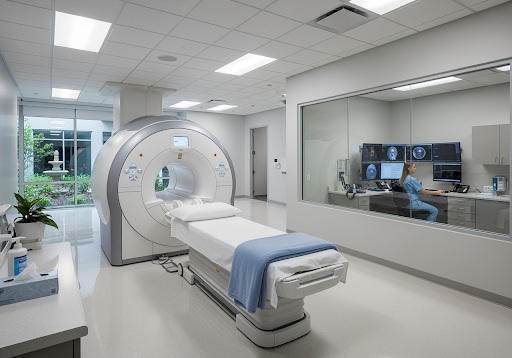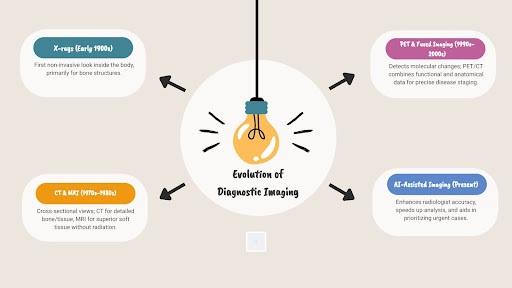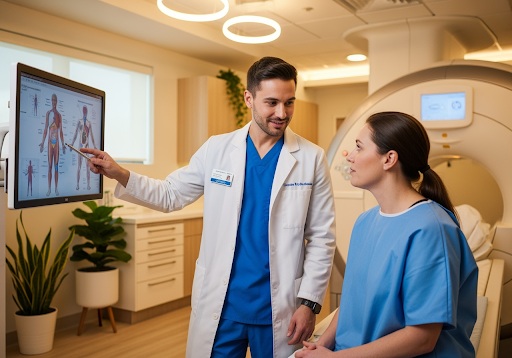The Technological Leap in Medical Diagnostics

Healthcare is changing rapidly. New tools and better ways to care for people are appearing all the time. These changes help us find health problems much sooner. They also help us care for people better, both inside and outside the clinic.
We will explore these important shifts. First, we will dive into advanced diagnostic imaging. This includes the “i scan diagnostic” approach, which uses cutting-edge technology to see inside the body like never before. We will see how these innovations lead to faster, more accurate results. For example, modern imaging often uses AI diagnostic support to help doctors make quick and precise diagnoses.
Next, we will look at how healthcare support is growing beyond just medical tests. We will discuss comprehensive systems that help people stay well. This includes specific support for college students facing unique health challenges. Join us as we explore how technology and compassion are shaping the future of health for everyone.

The landscape of medical diagnostics has undergone a profound change, driven by relentless innovation and a commitment to patient well-being. Today’s advanced imaging technologies offer unprecedented views inside the human body, enabling diagnoses at a cellular level, delivering faster results, reducing radiation exposure, and significantly enhancing diagnostic accuracy. This technological leap is epitomized by centers like iScan Diagnostic, which are at the forefront of redefining outpatient medical imaging.
Revolutionizing Imaging: From CT to PET/CT
At the heart of modern diagnostic imaging are technologies like Computed Tomography (CT) and Positron Emission Tomography (PET). A CT scan uses low-dose X-rays and sophisticated computer algorithms to generate detailed cross-sectional images of the body. These images are far more intricate than traditional X-rays, providing invaluable insights into the brain, neck, chest, abdomen, and skeletal structures. For instance, iScan Diagnostic’s Manila and Quezon City branches boast fast 128-Slice CT scanners. These advanced machines, combined with innovative software and image reconstruction technologies, deliver highly detailed images in significantly shorter scan times. Crucially, these CT scanners are equipped with dose reduction technologies that can decrease patient radiation exposure by as much as 60%, a testament to the industry’s commitment to patient safety.
Positron Emission Tomography (PET), on the other hand, is a medical imaging technique that allows us to visualize cellular-level activity within the body. By introducing a small amount of a radiopharmaceutical, such as Fluorodeoxyglucose (FDG), PET scans can detect metabolic abnormalities that often precede anatomical changes, particularly in cancer.
The true revolution, however, lies in PET/CT fusion. This combined modality integrates the functional information from a PET scan with the precise anatomical detail from a CT scan. The synergy provides a comprehensive picture of disease progression, offering deeper insights into the location and metabolic activity of conditions, especially cancers. For cancer care, PET/CT scans are now a standard tool, aiding in early detection, diagnosis, staging, treatment planning, and monitoring treatment response. They can reveal molecular changes earlier than anatomical changes, leading to more informed decision-making and potentially reducing unnecessary tests or surgeries. The PET/CT systems, like those at iScan Diagnostic, also feature advanced technologies such as Time of Flight (ToF), which improves lesion detection and image quality, further improving diagnostic accuracy and disease staging. These systems also incorporate dose reduction technologies, capable of reducing the CT dose in a PET/CT procedure by up to 60%. The entire PET/CT procedure, from registration to completion, typically takes around 2-3 hours, with results available the next business day.
The Power of MRI and Ultrasound
Beyond CT and PET/CT, Magnetic Resonance Imaging (MRI) and Ultrasound stand as pillars of advanced diagnostics, each offering unique advantages.
Magnetic Resonance Imaging (MRI) employs powerful magnets and radio waves to produce exceptionally clear and detailed images of soft tissues, organs, bone, and virtually all internal body structures. A key benefit of MRI is that it does not use ionizing radiation, making it a preferred choice for certain conditions and patient populations. It excels at visualizing structures like the brain, spinal cord, joints, and internal organs, providing unparalleled detail for diagnosing conditions ranging from neurological disorders to musculoskeletal injuries.
Ultrasound technology uses high-frequency sound waves to create real-time images of internal body structures. Like MRI, it is radiation-free, making it safe for pregnant women and children. Ultrasound is particularly effective for imaging soft tissues, blood vessels, and organs in motion. It’s widely used in obstetrics, cardiology (echocardiography), and for various abdominal and vascular studies. Its real-time capabilities allow for dynamic assessment, such as observing blood flow or organ movement, which is crucial for certain diagnoses.
Enhancing Safety and Precision
Modern diagnostic imaging is not just about clearer pictures; it’s fundamentally about enhancing patient safety and diagnostic precision. The integration of low-dose technology across modalities, as seen in iScan Diagnostic’s CT and PET/CT scanners, significantly minimizes patient exposure to radiation without compromising image quality. This commitment to dose reduction is a critical advancement, especially for patients requiring multiple scans or those undergoing screening programs.
Furthermore, innovations like Dual Energy CT can help reduce metal artifacts, which are common issues when scanning patients with implants. This technology uses different X-ray energy levels to improve image clarity around metallic objects and can even quantify kidney stone composition, aiding in treatment planning.
The drive for faster, definitive reads is paramount. Advanced imaging systems, coupled with experienced medical professionals, ensure that diagnoses are not only accurate but also timely. This efficiency is critical for managing illnesses that require urgent attention. The expertise of radiologists, often double-board-certified in various specialties, ensures that complex images are interpreted with the highest degree of accuracy. This blend of cutting-edge technology and human expertise ensures that patients receive the most precise and reliable diagnostic information available.
Improving the Patient Journey with Comprehensive Healthcare Support

Beyond the technological marvels, a truly patient-centered approach to healthcare focuses on the entire patient journey. This includes making services accessible, streamlining appointment scheduling, and ensuring fast, reliable results. Outpatient imaging centers like iScan Diagnostic are designed with these principles at their core, aiming to make advanced diagnostics convenient and less stressful for patients.
Streamlining the Appointment and Preparation Process
Making medical imaging accessible begins with a seamless appointment and preparation process. Modern diagnostic centers offer various ways to schedule appointments, including online booking systems and dedicated patient scheduling teams. This flexibility allows patients to choose the most convenient method.
Once an appointment is set, clear and comprehensive pre-appointment instructions are crucial. These instructions cover essential details such as:
- Fasting Requirements: For instance, abdominal CT scans typically require 8 hours of fasting, while other scans with intravenous (i.v.) contrast may require 3 hours.
- Lab Test Prerequisites: For any scan involving i.v. contrast injection, laboratory exams like serum creatinine and BUN are mandatory to assess kidney function. These lab results are usually valid if taken within two months.
- Communication with Technologists: Patients are advised to inform technologists about any allergies, asthma, or medication sensitivities. Women must disclose if they are pregnant or suspect pregnancy before scheduling. For specific procedures like MRI, informing staff about pacemakers or metal implants is vital.
This meticulous approach ensures patient safety and optimal image quality, contributing to the overall effectiveness of the diagnostic process.
The Importance of Fast, Accurate Results
In diagnostics, speed and accuracy are not just desirable; they are often critical. The ability to provide fast, definitive reads has a profound impact on patient care, reducing anxiety and allowing for prompt treatment planning. Centers like iScan Diagnostic strive to provide next-day results for radiology procedures, understanding that managing illness often requires urgent attention.
This rapid turnaround is often supported by advanced systems, including comprehensive Teleradiology Interpretation Services. Teleradiology allows images to be transmitted digitally to expert radiologists, who can interpret them quickly, regardless of their physical location. This ensures that even complex cases receive timely, specialized attention. The range of Radiology and Diagnostic Imaging Services available at such centers is extensive, including:
- PET/CT
- MRI
- CT
- SPECT
- Mammography
- Ultrasound
- X-Ray
- Cardiac Diagnostics
- Laboratory Services
The efficiency in delivering results directly influences the speed at which physicians can make informed decisions about patient treatment, ultimately leading to better health outcomes.
Creating an Accessible and Supportive Environment
An accessible and supportive environment is fundamental to patient-centered care. Outpatient imaging centers are designed to be easily reachable and comfortable. This includes:
- Convenient Locations and Operating Hours: Strategically located branches, often with extended operating hours, make it easier for patients to fit appointments into their schedules.
- Physical Accessibility: Facilities are typically wheelchair and stretcher accessible, ensuring that all patients can comfortably steer the center.
- Compassionate Staff: A team of experienced medical professionals and support staff who prioritize compassionate care helps alleviate patient anxiety and ensures a positive experience. From the moment of registration to the completion of the scan, every interaction is designed to be supportive and reassuring.
This holistic approach to patient care, combining advanced technology with a deeply human element, is what truly redefines outpatient medical imaging.
Expanding the Definition of Comprehensive Healthcare Support
Healthcare extends far beyond the walls of clinics and diagnostic centers. A truly comprehensive approach recognizes the interconnectedness of physical, mental, and social well-being. This expanded definition of healthcare support encompasses preventative care, health education, and community programs, and crucially, addresses the unique challenges faced by specific populations, such as college students.
Addressing Health Beyond the Clinic
Modern healthcare is increasingly focused on proactive measures rather than just reactive treatment. This involves:
- Preventative Care: Encouraging regular check-ups, screenings, and healthy lifestyle choices to prevent diseases before they start.
- Health Education: Empowering individuals with knowledge about their health, risk factors, and available resources.
- Community Health Programs: Initiatives that promote wellness at a broader level, addressing public health concerns and providing support systems within communities.
- Integrated Care Models: Approaches that coordinate various aspects of a patient’s care, including primary care, specialist consultations, and diagnostic services, to ensure a holistic and seamless experience.
By looking beyond the immediate need for diagnosis and treatment, we foster a culture of sustained health and well-being. This broader perspective aligns with our overall mission to improve health outcomes through innovative solutions and dedicated service, as detailed in our About section.
Unique Health Challenges for College Students
The transition to college life can be a period of immense growth but also significant stress. College students often face a unique constellation of health challenges that require specialized support:
- Transition to Independence: Navigating a new environment, managing finances, and making independent health decisions can be overwhelming.
- Academic Stress: The pressures of coursework, exams, and career planning can take a toll on mental and physical health.
- Mental Health Crises: Anxiety, depression, and other mental health conditions are increasingly prevalent among college students, often exacerbated by academic and social pressures.
- Access to Care on Campus: While many universities offer health services, they may not always be equipped to handle complex diagnostic needs or provide extensive mental health support.
These factors underscore the critical need for robust support systems custom to the student population.
Systems Supporting Student Well-being
Recognizing these challenges, many institutions and organizations are developing comprehensive systems to support student well-being:
- Campus Health Services: Providing accessible primary care, vaccinations, and basic medical attention directly on campus.
- Mental Health Counseling: Offering confidential counseling services, therapy, and support groups to address mental health concerns.
- Wellness Workshops: Educating students on stress management, nutrition, sleep hygiene, and other aspects of holistic health.
- Financial Aid for Medical Emergencies: Addressing the financial barriers to healthcare, which can be a significant burden for students. Organizations like The Orion Fund provide crucial assistance, offering College health crisis grants to students facing medical emergencies, ensuring that health crises do not derail their academic pursuits.
By investing in these multi-faceted support systems, we contribute to a healthier, more resilient student body, ultimately fostering success both academically and personally.
Frequently Asked Questions about Modern Diagnostic Imaging
What is the main difference between a CT scan and an MRI?
While both CT scans and MRIs provide detailed images of internal body structures, they operate on fundamentally different principles and are used for different diagnostic purposes. A CT scan uses X-rays to create cross-sectional images. It is generally faster and excellent for visualizing bones, acute trauma, bleeding, and certain lung or abdominal conditions. An MRI, on the other hand, uses powerful magnetic fields and radio waves to generate highly detailed images, particularly of soft tissues like the brain, spinal cord, muscles, ligaments, and organs. MRI does not involve ionizing radiation, making it a preferred choice for certain conditions and for patients who need multiple scans. The choice between a CT and an MRI depends entirely on the specific medical question the physician is trying to answer.
How should I prepare for a diagnostic imaging appointment?
Preparation for a diagnostic imaging appointment varies significantly depending on the type of procedure. However, some general guidelines apply:
- Follow Clinic Instructions: Always adhere strictly to the specific preparation instructions provided by your diagnostic center.
- Inform Staff: Crucially, inform the staff about any allergies (especially to contrast dyes), existing medical conditions (like diabetes or kidney disease), pacemakers or metallic implants, and if you are pregnant or breastfeeding.
- Fasting: For certain scans, particularly those involving the abdomen or requiring intravenous contrast, you may need to fast for a specified number of hours (e.g., 8 hours for abdominal CT, 3 hours for other i.v. contrast CTs).
- Lab Tests: If intravenous contrast is used, recent blood tests (e.g., serum creatinine and BUN) to assess kidney function may be required.
- Clothing/Jewelry: You might be asked to wear loose, comfortable clothing and remove all metal objects, including jewelry, eyeglasses, and hearing aids, as these can interfere with imaging.
Always clarify any doubts with the diagnostic center when you schedule your appointment.
How is AI being used in radiology today?
Artificial Intelligence (AI) is rapidly changing radiology by enhancing efficiency, accuracy, and patient care. AI algorithms assist radiologists in several key areas:
- Image Analysis: AI can quickly analyze vast amounts of imaging data, identifying subtle patterns or anomalies that might be difficult for the human eye to detect, thus aiding in early diagnosis.
- Workflow Optimization: AI tools can help prioritize urgent cases in the queue, reducing turnaround times for critical diagnoses.
- Dose Optimization: AI can help fine-tune imaging parameters to achieve optimal image quality with the lowest possible radiation dose, further enhancing patient safety.
- Measurement and Quantification: AI can automatically perform precise measurements of lesions, organ volumes, or disease progression, providing objective data for diagnosis and treatment monitoring.
- Second Opinions: In some cases, AI can provide a “second read” on images, offering an unbiased, data-driven assessment, particularly in areas like breast imaging.
While AI is a powerful tool, it acts as a complement to the radiologist’s expertise, augmenting their capabilities and allowing them to focus on complex interpretations and patient management.
Conclusion

The future of healthcare is undeniably bright, characterized by a dynamic interplay between groundbreaking technology and compassionate, integrated support systems. From the advanced capabilities of “i scan diagnostic” technologies like PET/CT, MRI, and low-dose CT, which offer unparalleled insights into the human body, to comprehensive patient-centered approaches that streamline the diagnostic journey, we are witnessing a profound evolution.
This evolution extends beyond the clinic, embracing a holistic view of well-being that includes preventative care, health education, and vital support for vulnerable populations like college students. By combining the precision of AI-assisted diagnostics with dedicated human expertise and robust community support, we are empowering patients with knowledge, reducing anxiety, and facilitating faster, more effective treatment. The continuous innovation in both diagnostic tools and support frameworks is not just improving health outcomes; it is redefining what it means to care for individuals in the 21st century.
